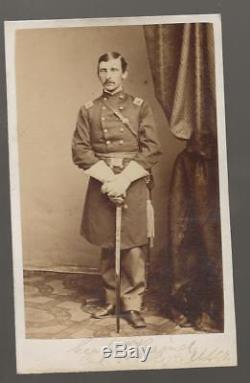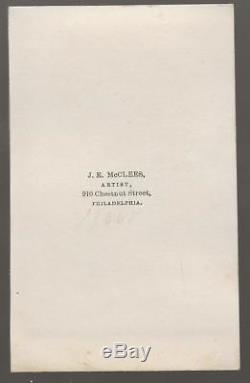
- Homepage
- Format
- Albumen (3)
- Ambrotype (30)
- Cabinet Card (58)
- Cdv (5)
- Crayon Portrait (2)
- Daguerreotype (24)
- Hardcover (11)
- Multi-formats (6)
- Negative Photo Image (4)
- Photograph (6)
- Ruby Ambrotype (3)
- Sixth Plate (2)
- Small (2)
- Stereoview (2)
- Tin Type (8)
- Tin Type Photo (2)
- Tintype (134)
- Tintype Photograph (6)
- Unknown (8)
- ... (6340)
- Framing
- Material
- Size
- Type
- Belt Buckle (3)
- Carte De Visite (2)
- Cdv (3)
- Cdv Photograph (14)
- Daguerreotype (3)
- Full Cdv Photo Album (2)
- Negative Film Photo (4)
- Pendant (3)
- Photo Album (3)
- Photo Frame (2)
- Photograph (1203)
- Photograph Album (39)
- Picture Book (7)
- Picture Frames (8)
- Print (3)
- Real Photo (rppc) (8)
- Tintype (9)
- Tintype Photo (4)
- ... (5336)
- Unit Of Sale
Civil War CDV Union Colonel George William Baird 32nd USCT Medal of Honor




Rare cdv of Colonel George William Baird of Milford Ct, Served as a private in the 1st Connecticut Light Artillery 8/62-12/63, VRC 41st Battalion 12/63-3/64 Colonel of the 32nd USCT 3/18/64 to 8/22/65 and served in the Army till 1903, Awarded Medal of Honor in 1894. November 26, 1906 (aged 66).
Union Army brigadier general rank insignia. 32nd United States Colored Infantry. Svg - Medal of Honor. George William Baird (December 13, 1839 November 26, 1906) was a US Army officer who received the Medal of Honor for his actions during the Indian Wars. Baird was born on December 13, 1839, in Milford, Connecticut.He graduated from Hopkins Grammar School in 1859, and later entered Yale University. Despite leaving Yale prior to graduation to fight in the American Civil War, he would receive his diploma in 1863. Baird joined the 1st Connecticut Light Artillery Battery in August 1862, and served with the unit until March 1864, when he was appointed colonel of volunteers of the 32nd United States Colored Infantry.
He mustered out with his regiment in August 1865, and was appointed as a second lieutenant of the 19th Infantry Regiment in May 1866. From 1871 to 1879, he served as adjutant of the 5th Infantry Regiment, commanded by Nelson A. Miles Baird later wrote the book General Miles's Indian Campaigns: On the Staked Plains. , and served under him in the Nez Perce War.
He became deputy paymaster general with the rank of lieutenant colonel in July 1899. Baird was eventually promoted to brigadier general on February 19, 1903, the day before his retirement. Aird died on November 26, 1906, in Asheville, North Carolina, and was buried in his hometown of Milford, Connecticut. Rank and organization: First Lieutenant, 5th U. Place and date: At Bear Paw Mountains, Mont.
Entered service at: Milford, Conn. Date of issue: November 27, 1894. Most distinguished gallantry in action with the Nez Perce Indians.Eorge William Baird is one of the first five local notables inducted into the Milford Hall of Fame. George William Baird was born December 30, 1839 in Milford, Connecticut.
His ancestry in America dates back to 1639, and includes in his fathers family line Captain John Beard, a soldier in the defense of Connecticut against the Indians. His family on his fathers side is descended from Thomas Hooker, the founder of the Connecticut Colony. His father, Jonah Newton Baird was a farmer who died while George was very young.
It was his mother, Minerva Gunn Baird, who George owed all the success in his life to because she made him into the man that any soldier would want to follow. Born in 1839, George formed habits of hard work when he was young because a strong constitution enabled him to begin work on the farm when he was only nine years old. Unoccupied time was unknown, and in the accomplishment of work he had undertaken he gained great satisfaction.Although most of his time was spent on typical farm work, reading and study were never neglected. For formal education, he attended Hopkins grammar school and graduated in 1859, entering Yale University at once which made him one of a tiny elite. In 1862, during the Civil War he enlisted as a private, but despite his absence due to military service, he received his diploma in 1863 with his class.
Even though he devoted his life to a career in the military, he always found pleasure and recreation in the reading of history and poetry. His military career began when he enlisted in the 1st Battery of Connecticut light Artillery in 1861. As a result of a competitive examination, he was promoted from the rank of private immediately to that of colonel in the volunteer army. After the appointment to colonel, he participated in several battles in South Carolina, Georgia, and Florida.The 1st Battery made an expedition to James Island and participated in operations against Charleston S. From May 31st to June 28th 1862. The major part of the expedition was the battle of Secessionville on June 16th 1862.
Later he was made Colonel of the 32nd Regiment of the U. The 32nd Regiment was ordered to Hilton Head S. In April 1864, and stood duty there until June.
When the Civil War ended he decided to make a career out of the military. He completed his engineering course at Sheffield Scientific school 1866, and in May of that year he was appointed second lieutenant in the regular army and in 1871 he became the adjutant-general of his field command. Written by Buddy Bajerski, Parin Christian George William Baird. Baird was awarded the Medal of Honor for his actions against the Nez Perce at the Bear Paw Mountains, in 1877. His medal citation reads that it was awarded For most distinguished gallantry in action with Nez Perce Indians. At the time of the Battle at the Bear Paw Mountains, Baird was a 1st Lieutenant. During the battle he served in the 5th Infantry Regiment nicknamed the "Bobcats".The 5th Infantry Regiment is the third-oldest infantry regiment of the United States Army, tracing its origins to 1808. It has participated in some way in most of the wars the United States has fought. The 5th Infantry was pursuing Chief Joseph and his tribe of Nez Perce Indians. The battle started when the Nez Perce saw the 5th Infantry Regiment advancing on their position.
The Indians didnt have time to flee, but they did have enough time to fortify their position. They made trenches in the side of the mountain to slow the advance of the attacking U. Custers outfit, the 7th Cavalry, charged in support of the 5th Infantry but was pushed back under a barrage of arrows shot by the Indian warriors. When the day was over, Colonel Nelson A.
Miles, the commander of Bairds Regiment, tried to negotiate a peace treaty with Chief Joseph. While this was going on, each side removed their wounded from the field.
On October 2, the United States' 12-pound Napoleon artillery piece arrived at the battlefield. The Napoleon artillery fired on the Indian trenches in hopes to force the Nez Perce to surrender, which they did. While he was giving orders and carrying notes across the battlefield, Baird was shot in the left forearm and an arrow severed his ear. Baird was presented the Medal of Honor in 1894. He was living in Milford at the time.
In conclusion, George William Baird is a great choice to exemplify what Milford wants in their citizens. Bairds career demonstrates that even if you come from a small town, you can still make a big impact for your nation. After he retired from the military, Baird was active in his town and his church. He died November 28, 1906 at the age of sixty seven. Baird is buried in the Milford cemetery with two plaques telling what he did to earn the Medal of Honor, his grave number is 6393190. The item "Civil War CDV Union Colonel George William Baird 32nd USCT Medal of Honor" is in sale since Wednesday, September 5, 2018. This item is in the category "Collectibles\Militaria\Civil War (1861-65)\Original Period Items\Photographs". The seller is "civil_war_photos" and is located in Midland, Michigan. This item can be shipped worldwide.
